|
||
 |
St. Louis SportsOnline |
|
||
 |
St. Louis SportsOnline |
Within the next few weeks, the St. Louis Cardinals plan to reveal the financing that has been arranged for their new stadium, which will be located just south of the old facility. This is according to news reports on the local radio and television stations. Little else has been reported by the local media during this search for the money.
The fans and general public have been told that a new ballpark would be a boost to the local economy. A new ballpark would lead to increased attendance and the ability for the local heroes to compete more effectively in the MLB marketplace.
There have also been reports concerning the waning interest in MLB activities (for example, Don Walker's column entitled "MLB attendance keeps on slippin'" from the Milwaukee Journal Sentinal). Even lately, new KMOX Cardinals radio broadcaster Wayne Hagen has stated that many of the new ballparks have seen a steady decrease in the number of fans attending games.
I thought that it might be interesting to take a look at Major League Baseball attendance in general and St. Louis Cardinals attendance in particular. With this in mind and with the thoughts from some columns on www.stlsports.com, I would like to offer some general information concerning MLB ballparks and attendance. My intent is to present some general trends and some specific effects. You the reader can use the compiled information to pose questions such as "Why do the Florida Marlins draw so few fans during the season but pack the ballpark during the playoffs? or Does it pay to have a big home run hitter like Mark McGwire on your team?"
Let's start with some general trends and two specific effects:
These major points are illustrated in an interesting graph of MLB and St. Louis Cardinals average attendance. The data were obtained from http://mtlexpos.tripod.com/attendance/ and Baseball Almanac.
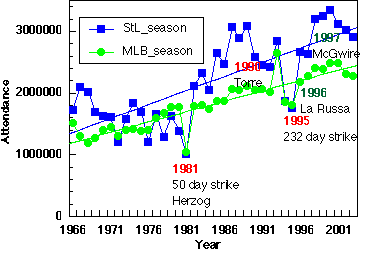
The upper graph illustrates the average attendance for MLB and for the St. Louis Cardinals over the period since the opening of Busch Stadium in 1966. The colored lines represent the best fit of the data to a linear equation (a straight line).
There is one general observation.
Total average attendance for MLB has been increasing!
Let me repeat this observation.
Total average attendance for MLB has been increasing!
In other words, while there are teams that are experiencing a decrease in average attendance, there must be teams that are experiencing an increase in average attendance or there is an increase in the number of teams. But overall, total average attendance for MLB has been increasing!
In 1966, there were 20 MLB teams, split evenly between the American and National Leagues. The progression to today's configuration may be seen in the following table.
| Year | AL | NL |
|---|---|---|
|
|
|
|
|
|
|
|
|
|
|
|
|
|
|
|
|
|
|
|
|
|
|
|
|
|
|
|
|
|
|
|
Over the period of time discussed in the column, MLB expanded from 20 to 30 teams, a 50% increase in size. So let's make a few assumptions:
We might then predict that average attendance would increase by 50% from 1966 to 2003.
AND BEHOLD! Average attendance did increase by 50% over this period of time (1.2 million to 2.4 million). Take another look at the figure above (or at the following figure of average game attendance).
So by adding seats and providing incentives for fans to attend games (put another way, don't scare off fans), MLB could grow attendance.
This is not rocket science, just common business strategy.
There are other ways to increase business. Conduct sales. Have free giveaways. Carry out promotions. Modernize facilities. You can probably think of alternative strategies.
I would like to consider promotions and facility modernization in particular. To do this, let's look at how each of the individual MLB teams fared from 1966 to 2003.
We start with the AL by looking at their ballpark histories. (General information about MLB venues were obtained from BALLPARKS by Munsey & Suppes.)
| Team | Year | Ballpark |
|---|---|---|
|
|
|
|
|
|
|
|
|
|
|
|
|
|
|
|
|
|
|
|
|
|
|
|
|
|
|
|
|
|
|
|
|
|
|
|
|
|
|
|
|
|
|
|
|
|
|
|
|
|
|
|
|
|
|
|
|
|
|
|
|
|
|
|
|
|
|
|
|
|
|
|
|
|
|
|
|
|
|
|
|
|
|
|
|
|
|
|
|
|
|
|
|
|
|
|
|
|
|
|
|
|
|
|
|
|
|
|
|
|
|
|
|
|
|
|
|
|
|
|
|
|
|
|
|
|
|
|
|
|
|
|
|
|
|
|
|
|
|
|
|
|
|
Consider the individual teams, which I have collected in groups of 4 or less. Note that there are typically large jumps in average game attendance for teams that move into new ballpark facilities. Some of these teams were able to maintain the attendance boost over a period of years, other teams quickly saw decreases in attendance. Some of the variation in attendance may be explained by the success of the team in winning their division, the league championship or the World Series. Note that the Boston Red Sox have been playing in the same ballpark since 1912. Later we will identify their National League counterpart.
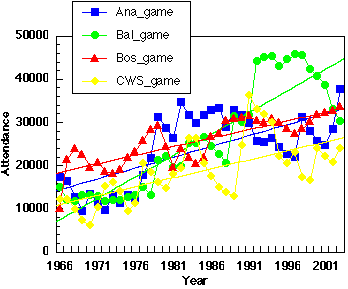
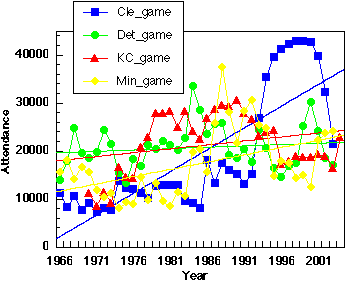
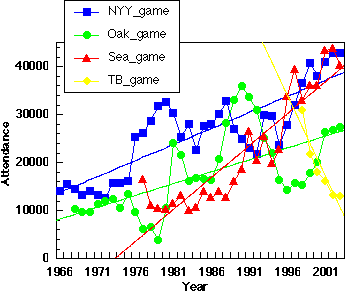
Of special note here is the decreasing average attendance for the Tampa Bay franchise.
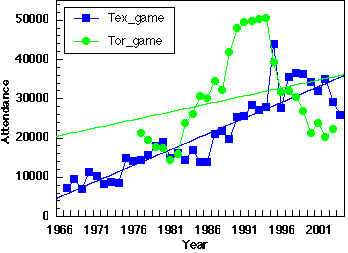
Now we turn to the NL and their ballpark histories.
| Team | Year | Ballpark |
|---|---|---|
|
|
|
|
|
|
|
|
|
|
|
|
|
|
|
|
|
|
|
|
|
|
|
|
|
|
|
|
|
|
|
|
|
|
|
|
|
|
|
|
|
|
|
|
|
|
|
|
|
|
|
|
|
|
|
|
|
|
|
|
|
|
|
|
|
|
|
|
|
|
|
|
|
|
|
|
|
|
|
|
|
|
|
|
|
|
|
|
|
|
|
|
|
|
|
|
|
|
|
|
|
|
|
|
|
|
|
|
|
|
|
|
|
|
|
|
|
|
|
|
|
|
|
|
|
|
|
|
|
|
|
|
|
|
|
|
|
|
|
|
|
|
|
|
|
|
|
|
|
|
|
|
|
|
|
As above, the individual teams have been collected in groups of 4 or less. Look for any large jumps in average game attendance for teams that move into new ballpark facilities. Were any of these teams able to maintain the attendance boost over a period of years? Are the variation in attendance related to the success of the team in winning their division, the league championship or the World Series. Note that the Chicago Cubs have been playing in the same ballpark since 1926.
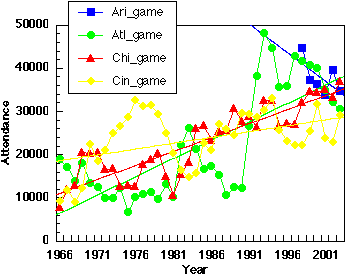
Arizona Diamondbacks have a relatively short history of attendance data.
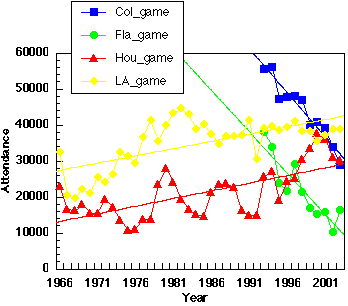
Of note are the decreasing attendance records for both the Colorado Rockies and the Florida Marlins, young expansion clubs.
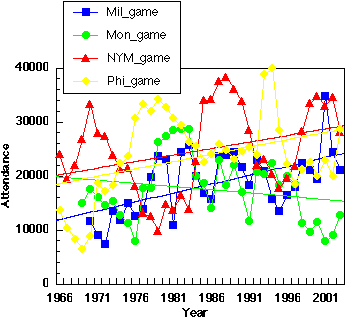
The Montreal Expos have a net decrease in attendance over the life of their ball team. The New York Mets have rather large swings in average attendance.
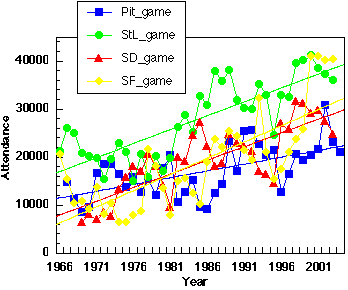
It's now time to take a more detailed look at our local franchise. We look at average game attendance for the Redbirds and MLB.
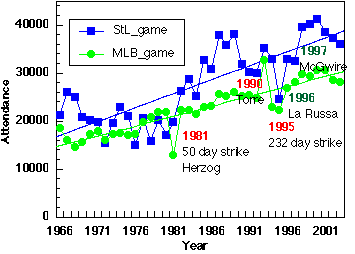
We observe that average game attendance parallels that of the average season attendance.
The Cardinals moved into their new facility on May 12, 1966. Initially season attendance figures were slightly above 2,000,000 people (22,000 to 26,000 per game). A figure that began to steadily decrease over the next 5 years and then bounced around the 1.6 million (< 20,000 per game) mark until 1981.
The first significant baseball strike occurred in 1981 (51 days, a split season). The average game attendance for the Cardinals was not affected. But the 1994-1995 strike was reflected in a decrease average game attendance. Did Cardinals fans change the way they viewed the National Pastime? Remember one of the business rules, don't scare away the customers.
| Year | Duration, days |
|---|---|
|
|
|
|
|
|
|
|
|
|
|
|
|
|
|
|
|
|
|
|
|
|
|
|
Attendance continued to increase until 1989, during which time the Redbirds had put together some winning seasons. These included NL Division championships, pennants, and several World Series appearances (a WS victory in 1982). Recall another business guideline, give customers promotions.
(Win-loss records were abstracted from Doug's NBA & MLB Statistics home page.)
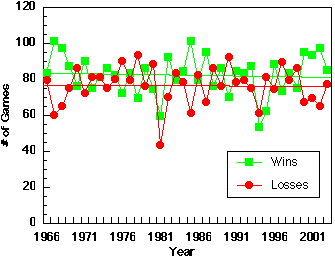
| Year | Titles |
|---|---|
|
|
|
|
|
|
|
|
|
|
|
|
|
|
|
|
|
|
|
|
|
|
|
|
There appears to be an inverse response between average attendance and team recognition such as NL Rookie of the Year or NL Manager of the Year (consider Albert Pujols and Tony LaRussa).
| Year | Player | Award |
|---|---|---|
|
|
|
|
|
|
|
|
|
|
|
|
|
|
|
|
|
|
|
|
|
|
|
|
|
|
|
|
|
|
|
|
|
|
|
|
|
|
|
|
|
|
|
|
But probably the most significant influence on attendance was in the person of Mark McGwire.
First baseman McGwire joined the Cardinals in 1997 and attendance saw a quick boost during his productive home run seasons. He broke Roger Maris' record in 1998 with 70 HRs and followed that production by hitting 65 HRs in 1999. This we could call the "McGwire boost." The increased attendance carried over to road games also.
Other teams more than likely had their own "McGwire boost." Consider the Cincinnati Reds and Ken Griffey, Jr. or the San Francisco Giants and Barry Bonds.
But as with all good things, they come to an end. As McGwire's productivity declined so tracked average game attendance. Layered over the McGwire boost was the fact that the Cardinals found it difficult to proceed further than Division champs.
Many people in the St. Louis area regard the city as the best baseball town. Is there a way of getting at the truth of this assertion?
One might say that the best baseball town would support their team during bad times as well as good times. One might see this reflected in season attendance records or average game attendance. An advantage of looking at average game attendance would be that in something other than a 162-game season, one would still get a good idea of how popular the local heroes were. Here's the graphic for the Cardinals from 1882 to 2003.
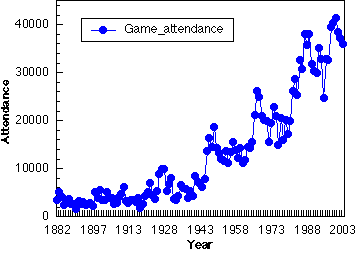
Sure, OK, I probably should suggest the use of the ratio of average game attendance to total ballpark capacity! You do the math using ballpark capacities listed for the AL and NL. Here is the graphic for the home town club from 1902 to 2003.
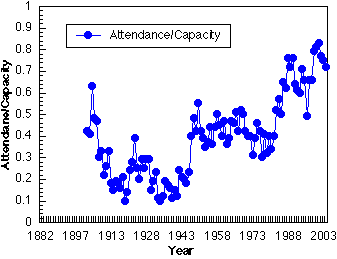
Or to be more precise, we should use the ratio of average game attendance to total ballpark capacity somehow normalized to the population density of the host city. In this way, one might know how loyal the local folks are to the MLB team even if it were a small market team.
In any case, we observe that over the lifetime of the clubs in St. Louis, there has been a progressive increase in both attendance and in the attendance to capacity ratio. As more data is compiled for MLB teams, we will report on the success in filling seats in ballparks around MLB.
I think one could make the argument that the Boston Red Sox, Chicago Cubs, Los Angeles Dodgers, and St. Louis Cardinals (in that order) may have the best baseball towns. I would justify this based upon attendance trends, ratio of average game attendance to total ballpark capacity, and attendance response to success of the team franchise.
The Editor welcomes your comments!
Taking all this information into account, I would ask the following question, which I think may get to the bottom of many arguments for and against investment in new ballparks.
What is the cost to benefit ratio of using anyone's money to finance a new ballpark?
That is to say, is it worth the money invested in MLB to get the observed results.
That question is asked everyday in businesses and other institutions that use investor money to promote specific projects and agendas.
At what cost?
Or, what would you pay for a successful MLB team?